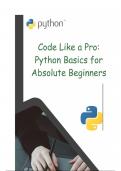, Unlock your Python potential!
Welcome to the world of Python, where coding is not just a skill but a
creative adventure! Whether you're a beginner or looking to sharpen your
programming abilities, this book is designed just for you. Packed with
diverse exercises, from simple scripts to more complex challenges, each
project is a stepping stone towards mastering Python.
Why Python?
Python is one of the most versatile and user-friendly programming
languages out there. It’s the language of choice for web developers, data
scientists, AI enthusiasts, and hobbyists. With its clear syntax and
powerful capabilities, Python makes learning to code both fun and
practical.
This book takes you beyond theory into the realm of practical application.
You'll write code that solves real problems, automate everyday tasks, and
even build games and mini-projects. With each exercise, you’ll gain
confidence, improve your problem-solving skills, and, most importantly,
enjoy the process of learning.
So grab your computer, and let’s dive into the world of Python exercises.
Start your journey today and watch your coding skills grow with every line
you write!
Are you ready to start coding? Let’s go!
,Chapter 1: Introduction to Python
1.1 What is Python?
Python is a high-level, interpreted programming language known for its
simplicity and readability. It was created by Guido van Rossum and
released in 1991. Python supports multiple programming paradigms,
including procedural, object-oriented, and functional programming. It is
widely used for web development, data analysis, machine learning,
automation, and more.
Key Features of Python:
● Easy to Learn and Use: Python’s syntax is simple and resembles
English, making it great for beginners.
● Interpreted: Python code is executed line by line, which makes
debugging easier.
● Open-Source: Python is free to use, and its development is
community-driven.
● Extensive Libraries and Frameworks: Python has a vast
ecosystem of libraries, such as NumPy, Pandas, Flask, and Django,
that make it versatile for various tasks.
● Portability: Python runs on various platforms, including Windows,
macOS, and Linux.
Why Learn Python?
Python is one of the most popular programming languages today. It is
widely used across industries for:
● Web Development (Django, Flask)
● Data Science and Machine Learning (Pandas, Scikit-learn,
TensorFlow)
● Automation (Scripting, Web Scraping)
● Game Development (Pygame)
● Internet of Things (IoT)
, 1. # Comments
Comments are lines in your code that the Python interpreter does not execute. They
are used to leave notes, explanations, or descriptions to make the code easier for
yourself and others. Comments help document what the code does and why it was
written in a particular way.
Types of Comments in Python:
1. Single-Line Comments
Single-line comments start with a `#` symbol and extend to the end of the line.
Everything after the `#` is ignored by the interpreter.
2. Multi-Line Comments
Python doesn’t have a specific syntax for multi-line comments like other languages,
but you can use multiple `#` symbols or use docstrings
Using multiple `#` symbols:
Using docstrings (though this is not technically a comment):




